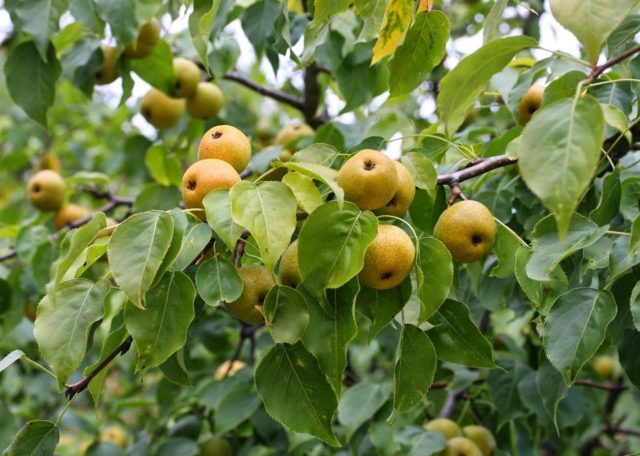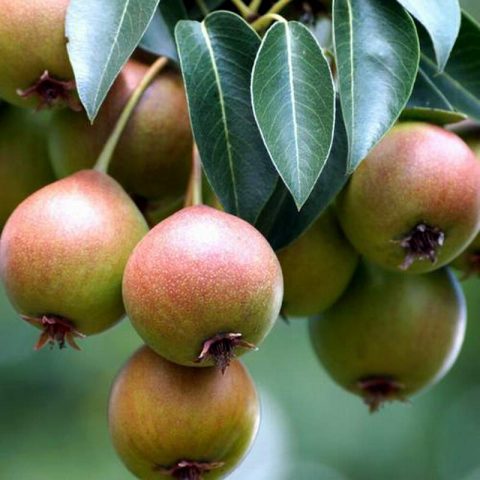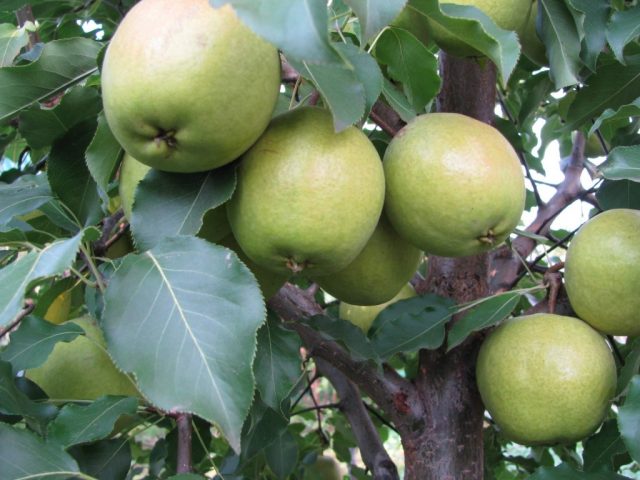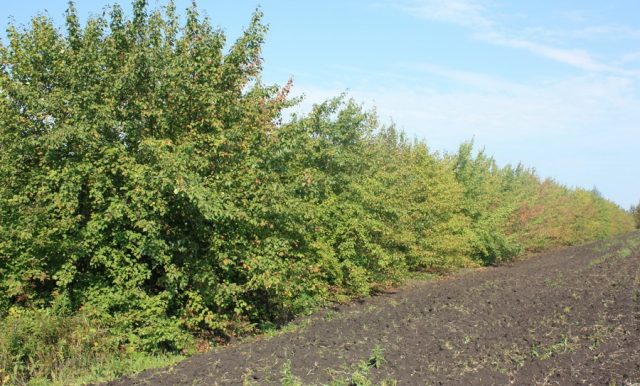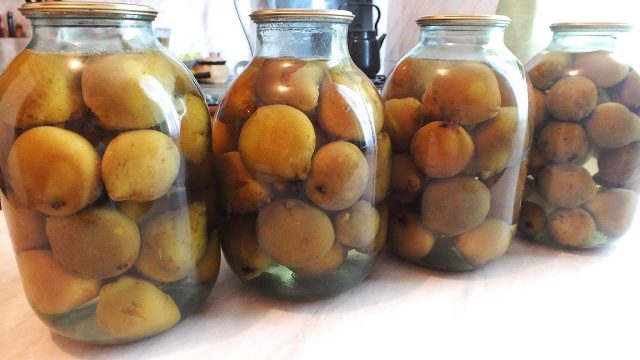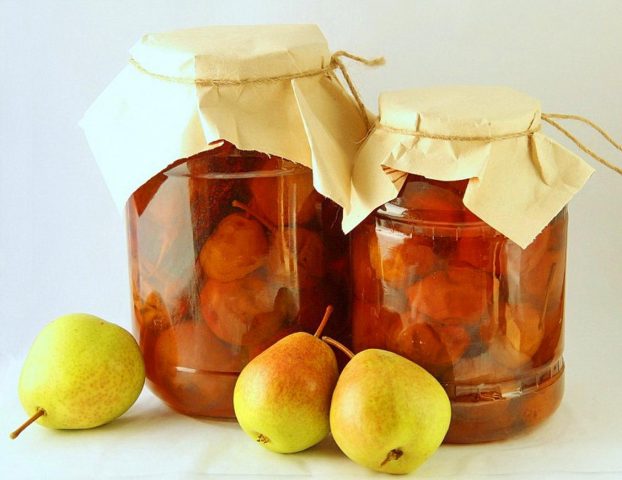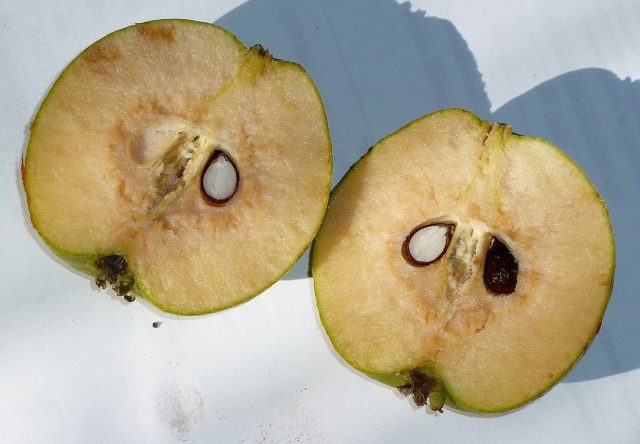Content
- 1 Description of the Ussuri pear
- 2 Characteristics of pear fruits
- 3 Pros and cons of the Ussuri pear variety
- 4 Using the Ussuri pear as a rootstock
- 5 Optimal growing conditions
- 6 Planting and caring for the Ussuri pear
- 7 Pollination
- 8 Yield
- 9 Diseases and pests
- 10 Ussuri pear recipes
- 11 Reviews of the Ussuri pear
- 12 Conclusion
Ussuri pear is an excellent option for growing in cold climates. It is used as a stock for other varieties. The tree is unpretentious, develops well with minimal maintenance. The fruits are used in cooking.
Description of the Ussuri pear
Ussuri pear is a representative of the Pear genus, the Pink family. It occurs naturally in the Far East, the Korean Peninsula and China. Grows singly or in groups near rivers, on islands, mountain slopes and forest edges. Under good conditions, it reaches 10 - 12 m, the trunk diameter is 50 cm.
Usually the tree grows up to 10 - 15 m. The bark is uneven, dark gray, almost black. Shoots glabrous, yellow-gray. The roots are located in the upper layers of the soil and do not penetrate deeper than 1 m. The crown is wide, oblong, thickened. The leaf plate is ovoid with a rounded base, serrate edges. The leaves are dark green and glossy above, lightish and matte below. In autumn they turn crimson-red.
Flowering begins before foliage appears and lasts 7 days. Flowers 3 cm in size, white, frost-resistant. Pollination occurs at the expense of another tree, so single plants do not produce crops. The flowers have a pronounced fragrant aroma.
You can evaluate the appearance and features of the Pear Ussuri variety in the photo:
Characteristics of pear fruits
Fruiting begins in late August and September. Ussuri pear ripens in clusters of 5 - 10 pcs. Fruits are medium in size, yellow in color with a crimson blush. The shape is round or oblong, the taste is tart. The pulp is rich in vitamins and organic acids. Average weight 50 - 70 g, maximum - 90 g.
The pear is suitable for consumption after a long period of storage. The fruits are processed: dried, prepared jam, compotes, tea.
Pros and cons of the Ussuri pear variety
Ussuriyskaya pear has a number of advantages:
- Frost resistance... The culture is grown in Siberia, the Urals and the Far East. The tree tolerates frosts down to -40 ° C without any problems. Minor damage is observed when the temperature drops to -50 ° C.
- Unpretentiousness... It grows in almost any soil, tolerates excess moisture and drought.
- Durability... In gardens, the lifespan is up to 80 years, in natural conditions - up to 200 years.
- Yield... Although the fruits are small, the crop yields high yields.
- Wide variety of varieties... More than 30 hybrids were obtained on the basis of the Ussuri species. They are distinguished by high frost resistance and productivity.
- Decorativeness... A blooming tree looks spectacular in the garden. The crown has the appearance of a ball, consisting of beautiful white flowers.
When planting the Ussuri species, its disadvantages are taken into account:
- Low early maturity... The first harvest from the Ussuri pear is obtained in 10 years. To shorten this period, the culture is provided with constant care.
- Presentation of fruits... The variety has no dessert purpose. Its fruits are small, have a sour and tart taste.
Using the Ussuri pear as a rootstock
The rootstock of the Ussuri pear tree is valued for its winter hardiness and durability. However, it is poorly compatible with varieties derived from the common pear. Best of all, hybrids derived from the Ussuri pear species take root: Severyanka, Long-awaited, Early Summer, Uralochka. As a result, the tree bears harvest earlier, the taste and quality of the fruit improves.
For vaccination, use one of the methods:
- Into the cleft... Suitable for cases where the rootstock is much larger than the scion.
- For the bark... It is used when the scion is smaller than the size of the rootstock.
- Budding... Single kidney grafting method.
The inoculation is disinfected with garden varnish to protect against diseases and pests. The graft is secured with tape and a plastic bag.
Optimal growing conditions
Ussuriyskaya pear is unpretentious to environmental factors. For successful cultivation, a culture is provided with a number of conditions:
- sunny place without shade;
- moderately fertile soils;
- lack of stagnation of water;
- the flow of fertilizers.
For planting the Ussuri Pear, a flat or elevated area is chosen. Landing in the middle of the slope is allowed. The soil must be drained, water and air permeable. Stagnant water in the soil is detrimental to the plant.
Planting and caring for the Ussuri pear
The further development of the Ussuri pear depends on the correct planting. Throughout the season, attention is paid to the tree: they provide the flow of moisture, nutrients, and the formation of the crown.
Landing rules
The Ussuri pear is planted in spring or autumn. Plants are chosen no older than 1 - 2 years. A planting hole is dug under the pear, which is left for 2 to 3 weeks to shrink. For spring work, the foundation pit is prepared in the fall.
The order of planting the Ussuri pear in the garden:
- First, they dig a hole 60x60 cm in size and 70 cm deep.
- If the soil contains clay, a layer of rubble is poured onto the bottom.
- Then a substrate is prepared from black soil, humus, 200 g of superphosphate and 100 g of potassium salt.
- The soil mixture is filled into a pit and a small hill is formed.
- A plant is planted, its roots are covered with earth.
- The soil is tamped, and the pear is watered.
After planting, the soil under the seedling is mulched with humus. At first, the tree is watered every 1 to 2 weeks.
Watering and feeding
Ussuri pear is watered before and after flowering. Lack of moisture during this period leads to shedding of the ovaries and a decrease in yield. Then the tree is watered only during the dry season.
The Ussuri pear tree responds positively to the intake of fertilizers. In early spring, nitrogen substances are introduced: a solution of mullein, urea, ammonium nitrate. When setting the fruits, they switch to feeding with superphosphate and potassium salt. Fertilizers are embedded in the soil or added to the water before watering.
Pruning
The first three years after planting, it is important for the seedling to form a crown. Several skeletal branches are selected, the rest are cut off. Be sure to remove dry, broken, frozen shoots. The procedure is carried out during a period when trees do not have active sap flow. Garden var is applied to the sections.
Whitewash
Whitewashing is performed in late autumn so that the bark does not get burned in the spring under the rays of the sun. The procedure protects the tree from the spread of pests. The whitewashing is repeated in the spring. They use a solution of lime and clay or buy ready-made compounds.
Preparing for winter
Ussuriyskaya pear tolerates even severe winters well. Preparation for cold weather includes abundant watering and mulching of the soil with humus or peat. Young seedlings are covered with agrofibre for the winter. It is attached to a wooden frame.
For fruit trees in winter, rodents are dangerous: hares and mice. To protect the bark from pests, a metal casing or mesh is used. The tree trunk is also wrapped in spunbond.
Pollination
The pear requires a pollinator to bear fruit. Trees are planted at a distance of 3-4 m. The main condition is simultaneous flowering. The process of pollination is influenced by weather factors: warm weather, lack of rain, cold snaps, strong winds.
The pollinator is not required if different varieties are grafted into the crown of the tree. Then, during flowering, they will be pollinated and yield crops.
Yield
Ussuriyskaya pear will be distinguished by high yields. Up to 70 kg of fruits are removed from one tree. The yield is stable from year to year. Fruiting begins at the age of 9 - 10. To speed up this process, other varieties are grafted into the crown. Then the fruits ripen for 5 - 6 years. To increase yields, regular care is required: watering, feeding, pruning the crown.
Diseases and pests
Most often, the culture suffers from scab. The disease takes the form of dark spots that appear on leaves, shoots, flowers and fruits. Gradually, the degree of damage increases, leading to drying out of shoots and spoilage of the crop. Bordeaux liquid is used to combat scab. In early spring, they begin preventive treatments with preparations containing copper.
For pears, black cancer and cytosporosis are dangerous. Diseases are spread by a harmful fungus that affects the bark, leaves and fruits. Good prevention is timely watering, top dressing, whitewashing of the trunk, harvesting autumn foliage.
Fruit trees are susceptible to attack by ticks, aphids, bark beetles, leaf rollers and other pests. Insecticides work well against insects: Karbofos, Iskra, Akarin, Metaphos.
Preventive work is effective: cleaning fallen leaves, cleaning the trunk, digging up the soil under the tree.
Ussuri pear recipes
Ussuriyskaya pear is perfect for canning. Both recently harvested and ripe fruits are used. The most popular preparations are compote, jam and jam.
Ingredients for pear compote:
- unripe dense pears for filling a three-liter jar;
- sugar - 500 g;
- water - 1.5 liters.
Detailed compote recipe:
- The fruits are washed and blanched in boiling water for 5 minutes.
- Then mix the fruit into a jar.
- Put water on the fire and add sugar.
- When the syrup boils, it is removed from the heat and the fruits are poured over.
- The jars are covered with lids and placed in a pot of water for pasteurization.
- The containers are sealed and cooled.
Jam is a dessert consisting of boiled pieces of fruit. In addition to pears, lemon juice, nuts, and other fruits are added to the mass.
Ingredients for pear jam:
- dense pears - 1 kg;
- granulated sugar - 1.6 kg;
- water - 2.5 cups.
The procedure for making jam:
- Peel off the fruit, then cut them into slices.
- The pieces are placed in a saucepan and poured over with cold water.
- The mass is boiled until softened.
- Water is poured into a saucepan and sugar is added. The syrup is brought to a boil.
- Fruit is dipped in hot syrup and cooked until tender.
- The jam is laid out in jars for the winter.
Jam is a homogeneous mass with grated fruit. Apples, nuts, honey are added to the blanks to taste.
Components for jam:
- ripe pears - 2 kg;
- sugar - 1.2 kg;
- water - 4 glasses.
Jam recipe:
- Ripe fruits are washed and cut into slices. The seed capsule is removed. The pear is placed on a blanching grid.
- Water is poured into a saucepan, the mesh is lowered and put on fire.
- When the fruits become soft, they are passed through a sieve.
- The resulting mass is put on fire and sugar is gradually added.
- The jam is boiled until tender.
To check how the jam is cooked, take one drop. If it doesn't spread, it's time to preserve the blanks.
Reviews of the Ussuri pear
Conclusion
Ussuri pear is suitable for growing in cold regions. It is planted for the fruits that are processed. Another direction was the use of the Ussuri pear as a rootstock.
